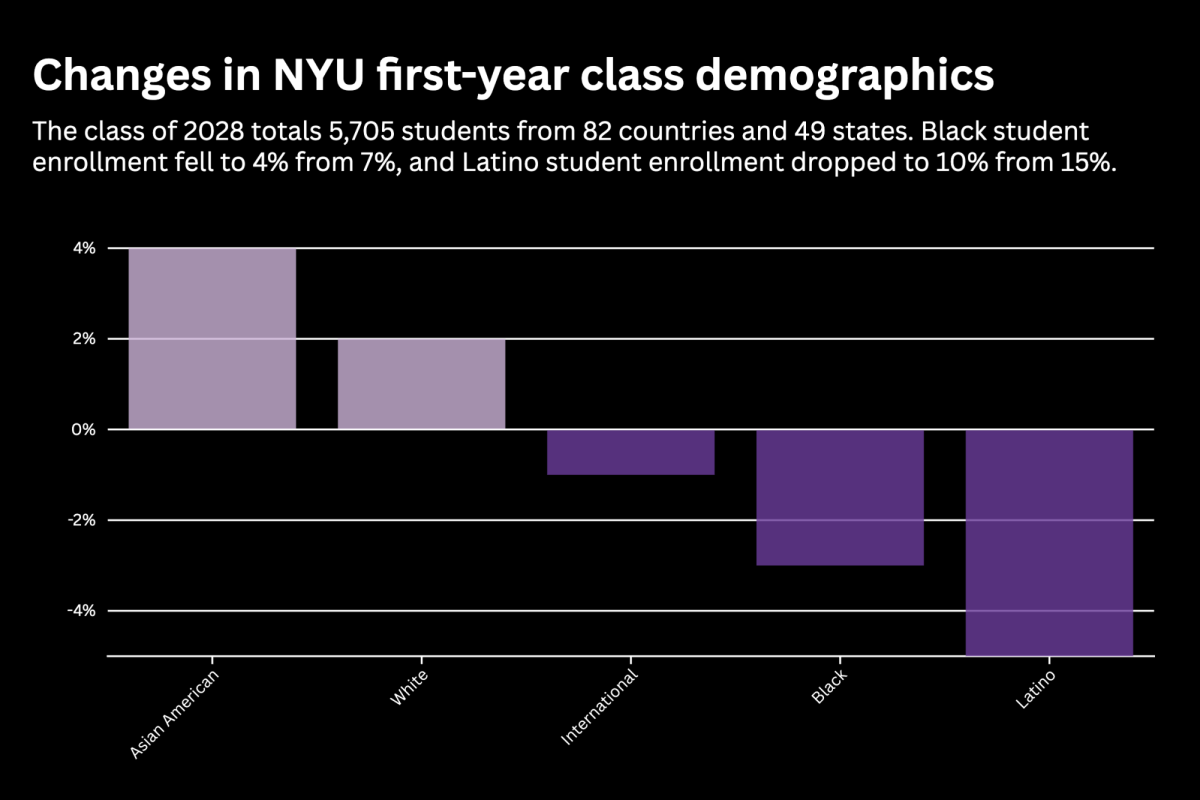Last June, the U.S. Supreme Court struck down affirmative action programs in college admissions, triggering a sharp decline in diversity across college campuses nationwide. In the lawsuit Students for Fair Admissions v. Harvard, the court ruled that race-conscious admissions programs were unconstitutional and violated the Equal Protection Clause of the Fourteenth Amendment. This 6-3 decision reversed decades of efforts to promote racial equity. In the months since, Black and Latino enrollment in many top universities has decreased significantly, including at the Massachusetts Institute of Technology, which has already seen a near 10% decrease in historically underrepresented groups enrolling in its class of 2028.
In conjunction with these trends, NYU saw a sharp decline in Black and Latino enrollment in its entering class of students. Among first-years, NYU’s historically underrepresented minorities experienced an enrollment decline of over eight percent in comparison to the year prior.
Since the Supreme Court decision, NYU stated its commitment to building and sustaining a diverse and inclusive community. Despite President Linda Mills’ claims that diversity is a core part of the university’s identity, the university has not explicitly addressed how it plans to counter the negative effects of the Supreme Court decision. This lack of a concrete plan threatens to undermine NYU’s commitment to diversity, particularly as declining students of color suggests the university’s vague stance may not be enough to reverse the current trend.
Affirmative action, first implemented in 1965, aimed to fight discrimination and provide equitable opportunities for the historically marginalized. In college admissions, affirmative action allowed colleges to take into account an applicant’s racial, sexual and religious background with preference given to applicants of marginalized groups.
Edward Blum — the president of Students for Fair Admissions who adamantly fought against and ultimately won the lawsuit striking down affirmative action — rejected the notion that systemic racism exists in the United States. However, evidence provided by the educational and employment sectors proves contrary to Blum’s claims. This should tell us all we need to know about what the true aim of this decision was — not to genuinely level the playing field for all, but to further an ideological agenda against students who benefit from affirmative action.
Academic assistance for those applicants of color who need it were solidified through affirmative action, allowing applicants to have the same access to educational resources as their white counterparts. Yet the striking down of affirmative action not only hinders access and equity for Black and Latino students to further their education, but also reinstates policies from a once segregated United States.
Since 1970, enrollment of Black, Hispanic and Asian students steadily increased in conjunction with the implementation of affirmative action. The decision demonstrably promoted equity, diversity and access for marginalized students and applicants that have been historically prevented from having these opportunities. Affirmative action offers equal and improved access to educational opportunities and resources, as well as provides all students, regardless of background, with a more diverse learning experience. Different backgrounds means different perspectives, and that is how we create new mindsets.
The striking down of affirmative action only strengthens modes of systemic racism against students of color. Economic barriers and the diminishment of employment prospects for students of color are all exacerbated in a world that doesn’t allow us to fully consider the backgrounds of students in their admission to universities.
So, what can be done to counter the reversal of affirmative action?
Institutions such as NYU can still employ creative strategies to maintain diversity in their admissions process. For example, the University of Michigan maintains an admissions framework where 75% of its freshman class were a part of the 10% of their high school. The remaining 25% of freshmen were admitted based on a combination of their Academic Index and Personal Achievement Index. Under the PAI, “special circumstances” such as race are considered, along with the students’ socioeconomic status. Through the use of concentrated training and reliability on AI and PAIs, college admissions officers are prepared to admit students based on a holistic and equitable framework.
The University of Texas at Austin also follows this integrated and comprehensive model of admissions to maintain levels of diversity and racial enrollment of its Latino and Black students. Through emphasis on personal and academic achievements while maintaining race as a subfactor in its decision-making, colleges, both public and private, can counter the effects of the striking down of affirmative action. NYU should follow suit, especially as a university that has called the striking down of affirmative action “a step backwards.”
We cannot ignore the persistence of systemic barriers faced by Black and Latino students. To take a colorblind approach to race is to not see the whole picture, and only leads to reinforcing existing racial inequities under the guise of neutrality. If NYU is truly committed to diversity, it must act decisively and transparently to create an admissions framework that actively promotes inclusion and equity for all.
WSN’s Opinion section strives to publish ideas worth discussing. Opinions expressed in the house editorial reflect the views of WSN’s Editorial Board.
Contact Leila Olukoga at [email protected].


























































































































































